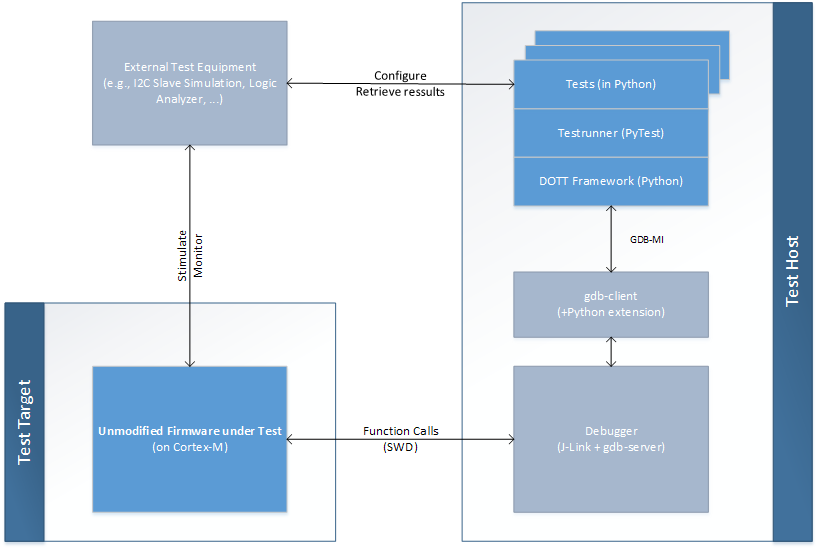 |
Debugger-based On-Target Testing
|
 |
Debugger-based On-Target Testing
|
The Debugger-based On-Target Testing 'new-gen' (DOTT.NG) framework is designed as an approach to simplify the on-target testing of firmware developed for Arm Cortex-M microcontrollers. It uses the debugger attached to the target device via SWD or JTAG to control, monitor and alter the execution of firmware on the target. Below is a summary of the goals addressed by the DOTT framework.
Primary goals for the Debugger-based On-Target Testing framework are to enable
Secondary goals for DOTT are
The figure below provides an overview of DOTT's architecture. On the test target on the bottom left the unmodified firmware under test is executed. Strictly speaking, the firmware is not entirely unmodified but a small test helper library is linked into the firmware (cp. Dev Guide). It provides a well defined entry point for the debugger. In practice, its effects on the firmware are negligible such that this entry point can be even left in place in the production version of the firmware.
On the right side, the debugger hardware is connected to the target via SWD or JTAG. A vital aspect for DOTT's approach is that the debug probe exposes a GNU Debugger (GDB) server interface for debugging clients to connect to. This is fulfilled by debuggers supported by the OpenOCD framework, PyOCD but also commercial debuggers such as Segger J-Link or PE micro debuggers.
Note: DOTT currently is developed and tested only with Segger J-Link debuggers. For J-Links it also supports auto-start of the GDB server.
On the next layer, a GDB client is used to connect to the GDB server. DOTT connects to the gdb client using the GDB machine interface (GDB MI). DOTT uses the PyTest unit test framework as test runner. The tests themselves, which are also implemented in Python, are executed by PyTest on the host where they have access to the target via GDB.
Optionally, the tests implemented in Python can also use additional libraries to interface with external test equipment to generate stimuli towards the target or monitor target outputs.

DOTT supports different approached for testing which are described below. A fundamental feature of DOTT used for all tests types is its ability to automate the programming of the target's FLASH memory and to bring the target into a defined state (target reset).
DOTT supports the implementation of component (unit) tests where an isolated function (or set of functions) is tested by providing input vectors and checking output vectors. Input vectors are defined in the tests implemented on the host and are provided, via the debugger, to the function(s) on the target. Output vectors are transferred back to the host where they are checked against expected results. With DOTT it is not only possible to invoke functions implemented in the target's firmware but it is also possible to inject (faulty) data into the execution flow. E.g., if the function under test calls some other functions, the return values of these functions can be changed and the reaction of the function under test can be observed.
For component testing, the target is typically booted up and halted at a certain location (test hook). Functions under test are then called from the context of this test hook.
The free-running mode is meant for system testing where the target is running and stimuli are provided to the target via its external interfaces (e.g., I2C). In addition to observing and checking the response to the stimuli in the public interface DOTT allows to add breakpoints to the target such that, e.g., it can be verified that a given stimulus actually triggers expected on-target functionality. One can also check if if externally provided data was correctly written into target memory (e.g., think about checking for endianess issues when doing data deserialization). Another usage example would be a bootloader where FLASH erase/write operations are triggered via the target's external interface and DOTT allows to inspect the target's memory and verify if it was correctly written/erased.
DOTT was originally developed internally at ams AG (later ams-OSRAM AG) to simplify automated testing of firmware for Arm Cortex-M microcontrollers. In spring 2021 it was decided to release DOTT via GitHub to the public.
In fall 2022, the development of DOTT was discontinued and a fork called DOTT-NG (aka new generation) was created on Github where development continues under the same open source (Apache 2) license. DOTT.NG is maintained as a privately run open source project and is no longer connected to ams-OSRAM AG. Contributions from industry and the open-source community are welcomed and highly encouraged as long they follow the guidelines in the included CONTRIBUTING.md. Please submit your feature requests, bug reports and support questions via the project's GitHub issue tracker
The documentation for the Debugger-Based On-Target Test Framework is structured as follows:
This documentation was built based on the following docu repository version: